

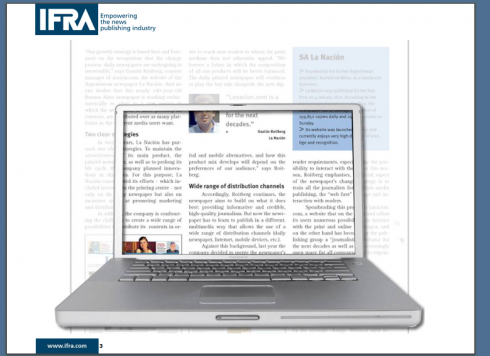

Left—see how a 3-column grid appears on the screen, as opposed to the easier-on-the-eye wider columns for eye movement that is primarily left to right on the screen.
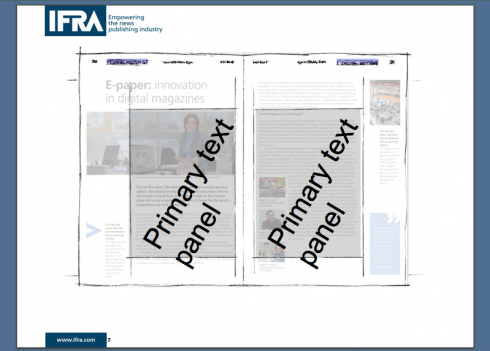
Here is how the primary text grid works
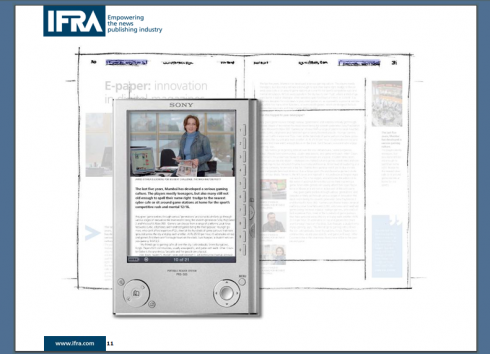
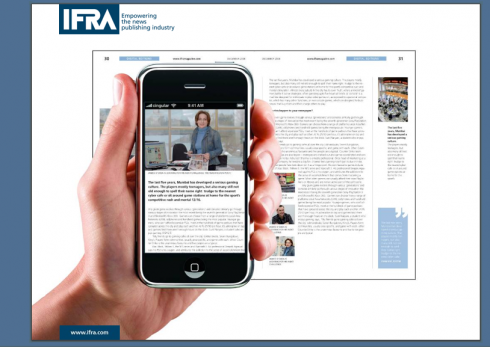
Here we see how the print design adapts to other applications, such as a SONY tablet or the iPhone
The following piece is reprinted from the January 2009 edition of IFRA Magazine, where I explain the thinking behind the new design:
Between printnets and digital natives
When Kerry Northrup, IFRA’s Publications Director, first approached me about taking a look at the association’s magazine and rethinking its look, I examined two editions prior to our
meeting in Frankfurt, and decided that, indeed, this was not a bad looking publication. It had a good navigational system, clean, legible typography, and even generous use of white space. So, I asked myself, what is it that IFRA wants to change, and, most importantly, why?
It was when we sat down for a full briefing that I began to get the idea of what this project involved – and, I admit, when I truly became excited about the prospects of working with Kerry and his team on this. No print publication should be rethought today without paying attention to its digital companions. I agree with William Powers, media columnist for the National Journal maga- zine, who writes that “print is eternal.” However, it will only be eternal if it adapts to changes that are too rapid to assimilate properly. For editors, it is a constant dilemma about content and how to treat it; for publishers, the questions are many, and range from running the finances of their firms across multi platforms to how to give each of the platforms its appropriate role, while attractingnew audiences without alienating the loyal ones.
In fact, when Rupert Murdoch recently addressed the American Society of Newspaper Editors, he said:
“I come to this discussion not as an expert with all the answers, but as someone searching for answers to an emerging medium that is not my native language. Like many
of you in this room, I’m a digital immigrant. I wasn’t weaned on the web, nor coddled on a computer. Instead, I grew up in a highly centralised world where news and information
were tightly controlled by a few editors, who deemed to tell us what we could and should know. My two young daughters, on the other hand, will be digital natives. They’ll never
know a world without ubiquitous broadband Internet access.”
Some get more specific than that. For example, Philip Meyer, author of the book “The Vanishing Newspaper,” examines today’s declining readership and states that the last reader will recycle the last printed paper in 2040 – April 2040, to be exact. My last grand- child, born November 10, 2008, will be 31 then, indeed, a digital native. However, in between, we are going through a period of transition, where readers who grew up with print but who have taken quickly to the charms and efficiency of the Internet, go easily from col-
umns of printed text to Google screens. It is a back-and- forth journey, repeated several times daily, which in fact brings about some definite reading behavioural patterns: These readers can read deeply, but they are voracious scanners who value effective navigation and who are not very forgiving when it comes to design that is intricate and not functional.
Maybe these are not yet among Murdoch’s digital na- tives, but they are what I would call printnets – at home in both the worlds of print and the Internet. They vary in age from 35 to 80 – as we were able to verify during the 2007 remake of The Wall Street Journal. We have an obligation to design publications that cater to them, the pre-digital native audience.
Perhaps our design concept for IFRA Magazine, which like many newspapers and mag- azines worldwide has an ePaper edition as its companion, is one of the first examples of a
systematic approach to creating a visual presentation that is as good for the printed edition as for its ePaper version.
The concept
Kerry and I sat down for hours and I took my sketch pad out. Soon, I was looking at the canvas of the printed page, and comparing it as it appears on the screen for those
reading the ePaper edition. The first thing that caught my eye was the page architecture. The traditional magazine grid of three columns of text, which works extremely well for
print, may not provide the best solution for those reading on a screen, where the eyes move horizontally across from left to right. The up and down movement of narrow col-
umns so familiar in print definitely does not do the job as effectively on a screen. We created a grid that adapts to both, allowing for a two-way traffic with deep reading
in the wider column measurement, and for scanning, secondary readings in the narrower columns.
The new IFRA Magazine design you see accommodates both well, with a variety of grid structures for photo positioning, quotes, additional information, and good architectural contrast between the elements.
This may very well be a solution that even daily newspapers may be willing to experi- ment with. And, yes, I still think that the printed product of the future will be more compact, thus facilitating grids similar to those you see now in your IFRA Magazine. It is never too late to prepare our publications for the digital natives, and, definitely, it is
time to make sure that we don’t alienate the printnets who move from our print to our digital products with great ease.
Listen to Mario on the new Tyler Brulé Monocle Radio show Sunday
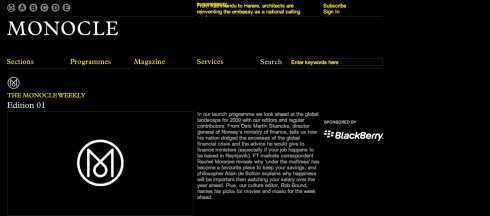
The show will broadcast Sunday, Jan. 11, at 12 noon Central European Time. Also appearing in the show: Arianna Huffington, of Huffington Post, and Khaled Abdel Shafi, Head of UN development programme in Gaza.
Tyler, who is a weekly columnist for the Weekend Financial Times, has started a new radio venture, as part of his Monocle Magazine. On December 28 he launched the first edition of a weekly radio programme that is broadcast on monocle.com and downloadable on itunes. It’s hosted by Tyler , with a variety of guests each week.
My exchange with Tyler is about the future of the media, with emphasis on newspapers and what their role will be in a multiplatform media environment.
For details, go here:
http://www.monocle.com/webprogrammes/The-Monocle-Weekly/Edition-01/
![]()
The following items from the IFRA Executive News Service today may be of interest:
English:
– Google news – CEO Eric Schmidt wishes he could rescue newspapers.
http://money.cnn.com/2009/01/07/technology/lashinsky_google.fortune/index.htm?postversion=2009010711
– Dan Froomkin: What Google Can Do for Journalism
http://blog.niemanwatchdog.org/?p=633
– Mecom close to sale of German newspaper unit-source
http://www.guardian.co.uk/business/feedarticle/8208655
– Why Newspapers Should Do More Online Video Marketing
http://www.reelseo.com/newspapers-video-marketing/
– USA: Buyer Saves Two Connecticut Dailies
http://www.editorandpublisher.com/eandp/news/article_display.jsp?vnu_content_id=1003927518
– USA: Sun Times says will accept investor decisions
http://biz.yahoo.com/rb/090107/business_us_suntimes.html?.v=1
– UK: Daily Sport publisher Sport Media Group records £18.2m pre-tax loss
http://www.guardian.co.uk/media/2009/jan/08/sport-media-group-loss
– UK: Trinity Mirror to centralise production of south-east weeklies
http://www.guardian.co.uk/media/2009/jan/07/trinity-mirror-to-centralise-production-of-south-eastern-weeklies
– UK: Northern Echo journalists call off industrial action
http://www.pressgazette.co.uk/story.asp?sectioncode=1&storycode=42760&c=1
– UK: Print beats online for ads says Deloitte
http://www.brandrepublic.com/News/871686/Print-beats-online-ads-says-Deloitte/
– USA: Online, Direct to Grow as 26% of Small Biz Ups Ad Spending
http://www.mediabuyerplanner.com/2009/01/07/online-direct-to-grow-as-26-of-small-biz-ups-ad-spending/
– Urgent Deadline for Newspapers: Find a New Business Plan before You
Vanish
http://knowledge.wharton.upenn.edu/article.cfm?articleid=2130
– USA: Tribune Co. Partnering With Online Ticket Seller
http://www.editorandpublisher.com/eandp/departments/ad_circ/article_display.jsp?vnu_content_id=1003928063
– USA: Chicago Tribune Has the 411 on Local News
http://biz.yahoo.com/prnews/090107/cg56605.html?.v=1
– UK: Salvation Army paper the War Cry goes tabloid after 130 years
http://www.guardian.co.uk/media/2009/jan/07/war-cry-goes-tabloid
– USA: ‘East Valley Tribune’ Relaunches as four Free Tabs in Phoenix
Market
http://www.editorandpublisher.com/eandp/news/article_display.jsp?vnu_content_id=1003927528
– Spanish newspaper ad revenues drop 20 pct in 2008
http://www.guardian.co.uk/business/feedarticle/8207688
And don’t miss this: file under The End of the Book?
Found while perusing the Tina Brown site, TheDailyBeast.com—-one that is always full of juicy surprises:

Roll over, Gutenberg! Publishing legend Jason Epstein says the only way to save the book industry is to get rid of all the books.
http://www.thedailybeast.com/blogs-and-stories/2009-01-08/an-autopsy-of-the-book-business/
Here is an excerpt that may seduce you to read the entire Jason Epstein piece:
The (book) business as it exists cannot survive, but in the miraculous way such things happen, a shining future is at hand. The 500-year-old Gutenberg system in which copy is delivered to a printer who ships inventory to a publisher’s warehouse from which it is consigned to bookshops is being displaced by the combined impact of digitization and the Internet, whose vast implications for the existing supply chain have yet to be fully exploited or perhaps grasped by today’s industry. In theory, every book ever published in whatever language can now be stored and delivered in digital form as cheaply and quickly as e-mail to be downloaded onto a variety of devices from dedicated readers, to more versatile handheld devices and to free standing machines that quickly and cheaply print and bind a selected title on demand wherever electricity and Internet connectivity exist. (I am involved in the development and exploitation of such a device called the Espresso Book Machine.) Authors’ complete works may be downloaded practically anywhere on Earth from appropriate websites, their property protected and royalties conveyed by secure software.
Chicago Tribune responds to complaints from readers about redesign
http://www.editorandpublisher.com/eandp/news/article_display.jsp?vnu_content_id=1003928440
Editor & Publisher
In Thursday’s Tribune, editor Gerould W. Kern uses a format of listing reader complaints under the hed “You Told Us” and responding “What We’re Doing.” He promises the paper will work on its confusing navigation and says the Tribune has been “refining our approach” to objections that the paper has become “too loud.” Also, the Tribune will bring back the business section as its own section front.
….And the rebuttal:
In the Romenesko column, www.poynter.org:
http://www.poynter.org/column.asp?id=45
Chicago Tribune to E&P: We didn’t apologize for our redesign

To read TheRodrigoFino blog, in Spanish, go:
https://garciamedia.com/latinamerica/blog/
Today, Rodrigo Fino writes about newspaper design
TheMarioBlog posting #163